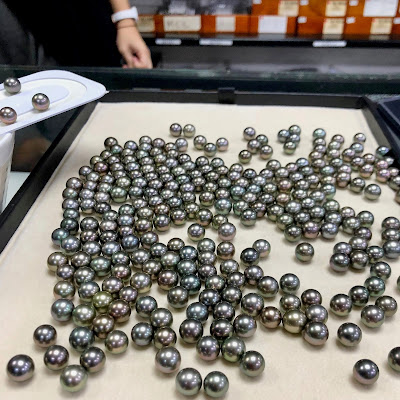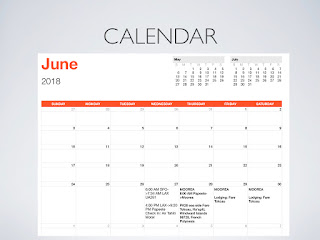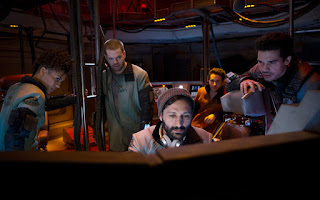 |
| Bannerfish |
Ever since reading “Travels”, by Michael Crichton of Jurassic Park fame, I’d been fascinated with Rangiroa Atoll. In his short essay entitled, “Sharks”, he thrillingly described diving in Tiputa Pass in Rangiroa. He described drifting rapidly through a school of sharks with his family, then ducking into a crevasse, only to submerge into another herd of surprised, Gray Reef Sharks. The family emerged shaken, but itching to do it all over again. I very much enjoyed reading the short essay at the time, but dismissed it as an impossible pipe dream for a broke college student. Never in my wildest dreams would I imagine I’d repeat the same, thrilling dive.
Fast-forward 20 years to present day. My husband and I decided to go to Rangiroa as part of a larger French Polynesian holiday. I was more excited about experiencing the paradise of Moorea and Bora Bora than I was about diving Rangiroa. Based on the lack of coverage of Rangiroa in American dive magazines, I had lowered expectations about diving in Rangiroa. However, Rangiroa far exceeded my expectations for diving. It was some of the most challenging, most thrilling dives I’ve ever done.
 |
| Titan Triggerfish |
Thrilling Dive
“Are you guys comfortable with decompression diving?” our divemaster, Antoine asked us after introducing himself. “Deco diving” was precisely what I worried the most about diving in Rangiroa, not diving with sharks. After not having scuba dived in a year, the idea of diving in high current, being encumbered with an underwater camera, AND being at depth was a little daunting. (Decompression diving, for the uninitiated, is any scuba diving performed past the time limits prescribed by one’s dive computer, or dive tables. It requires additional skill and dive planning because it demands that divers stay at depth to off-gas before surfacing.)
I looked to my husband, Mark, and the young female French internist who would make up our small group and none seemed to object. Encouraged by our seeming confidence, the dive master recommended we dive the “Canyons”. We would enter the water outside of the lagoon, look around for dolphins and sharks, then enter one or two crevasses in the pass to escape the current. In the channels there would be a lot of life, Antoine said. We could then do our safety stop at the sand bar in the middle of the pass.
A mere minutes after gearing up, we back-rolled off the inflatable zodiac and plunged head-first into the blue. The water was so clear (the visibility was ~200’) that we could see tiny divers playing with a column of barracuda several stories above us. This betrayed to me that we were already quite deep.
But we descended further. As we neared our 120’ max depth, I realized that swarming more than 30' below us were over a hundred Gray Reef Sharks. It was like a scene from a horror movie where the heroine turns on the lights only to see aliens swarming into the dark. Only here, the aliens were sharks. (Later on, I would learn that the sharks were circling into the current over and over again, where they found it easier to breath.)
 |
| Christmas Tree Worms |
Our visit with the sharks over, we approached the pass, a barren moonscape. I looked at my dive computer and noticed I only had 2 minutes of no-deco left. I hurriedly ascended a few feet above our group, but got swept further downstream. The current high up was much faster. I kicked as hard as I could to enter the crevasse, and to rejoin my group, and was conscious of my panting. I checked my air-I had blown through 500 psi. There was not enough time to worry about that, however. All around me were innumerable banner fish, surgeonfish, and butterfly fish taking shelter from the current and I swiveled around to take it all in.
Pretty soon it was time to kick off, and off we went. Despite my best efforts, I got blown off again on a much faster slipstream. Learning my lesson from earlier, I deflated my BCD in order to sink and hug the bottom as much as possible, and collided straight into the razor sharp hard coral. Like a rock-climber, I hung on for dear life with one hand. I could see Antoine more than 50 feet away, and I could see Mark furiously kicking to meet up with Antoine. I let go of my handhold and kicked towards them, but found myself getting swept further and further away. I arrested myself several times by grabbing onto whatever sharp coral or rock I could find with my available hand (my other hand was holding my camera), but using just one hand was simply not enough. Finally, Antoine swam over to come retrieve me and together we half-climbed, half-finned our way over to where my husband awaited.
Decompression...
Eventually we managed to kick our way to the sandbar where the current had subsided. But there was a problem. Mark, who was already buddy-breathing at this point with the divemaster, showed us his wrist-mounted dive computer. He still had 30 minutes of decompression left. I checked my console. Although my computer said I was already in the clear (I have a far less conservative computer), my air was at a new low - 500 psi. I usually have the most air left out of everyone. I could only extrapolate how empty everyone else's tanks were. We were all running out of air and we still had a significant mandatory waiting period to go.
 |
| Giant Clam |
Feelings of fury and grief washed over me, with tears almost welling out of my eyes. I had already watched Mark’s GoPro camera flood on one of our earlier dives, which had him reduced to lugging it like a useless appendage for the rest of the dive. I was already heartbroken for my husband’s disappointment. And now this? I feared that Mark would be traumatized, or even ashamed about being low on air, when in fact, it wasn’t his fault. (Mark has excellent air consumption, and all of us, even the divemaster was low on air.) I feared that our dive vacation was ruined.
Fifteen minutes of no-deco left. Our dive boat, having spotted our divemaster’s SMB (surface marker buoy), had parked itself above us. They had already finished picking up the other group and were just waiting for us to finish and board. The boat bobbed gently in the sunlight, so close, and yet so far. At this point, the divemaster asked that Mark breath from my octopus, since he was too low on air to continue buddy-breathing. I was down to 300 psi, nearly empty with 15 minutes left to go, but offered my octopus to my husband. I quieted myself, breathing as slowly and sparingly as possible. As we waited I watched blood rising slowly from my wounded hand, which was caused by my attempts to self-arrest in the current. Even at 10 feet of shallow water, the blood looked green.
 |
| Bloody Hand |
Finally, it was time to surface with air still left. We had caused the rest of the divers on the boat to wait for us in the exposed sun for 30 minutes, so we probably looked quite ragged as we boarded the boat. One of the other French divers, an IT specialist, widened his eyes when he saw red blood running down my hand onto my wetsuit. It looked much worse than it actually was. A little antiseptic, and I was good to go. More importantly, Mark was equanimous about the situation. He realized his computer was being overly conservative and that he could have monitored his own depth better. And he didn’t let the flooded camera, a separate issue, cloud our vacation. Later on, while driving the van back to our hotel, Antoine apologized for taking us on such a “technical” dive. He hoped we weren’t too traumatized. “Are you kidding me?” I replied, “That was one of the funnest dives, ever! I will remember that dive for the rest of my life!”
Rangiroa of my Dreams
Later on, we would have amazing dive after amazing dive in Rangiroa. We encountered a school of spawning surgeonfish, a once-in-a-lifetime opportunity. And we had a memorable 20 minute long play session with dolphins. After requesting to do the Canyons dive again, however, we were denied. Many of our dives were great, but I think our Canyons dive was the most memorable because I had experienced every emotion all on a single dive - excitement, and adrenaline, followed by physical pain, fury, grief, and finally relief.
It wasn’t until we had come home, and I had reread Michael Crichton’s tale,“Sharks” (now downloaded-my paperback was long gone), that I realized that the memorable dive that we had conducted was the very same dive he had written about in such exciting fashion, and that I had dreamed about doing 20 years earlier.
 |
| Relaxing after Diving |
Advice
If I could do it all again, I would do almost everything the same, including using the same dive operation. However, I would probably add a few tweaks. Here are my recommendations, and things I would do differently the next time around.
- Get the Te Moana dive pass. This dive pass allowed us to dive throughout French Polynesia at a reduced bulk rate.
- Wear gloves. The current is so fast and so strong here that merely kicking won’t hack it. It is necessary to grab rocks or coral to arrest yourself in the current.
- Monitor your depth and no-deco limits constantly.
- Be familiar with your dive computer’s graphical screen during a decompression protocol.
- Stay above the divemaster if possible - that is until you enter the pass, in which case, stay low to avoid the worst of the current.
- Stay as close to the sides of the pass where the current is slower as much as possible.
- Do the incoming current dive. And if possible, do the “Canyons” dive. This was the thrilling dive that was described in Michael Crichton’s book, and which I described above.
- Always do the sunset dive. The two sunset dives we did were easily some of the most exciting dives we conducted. They were also the most interesting from an animal behavior standpoint. We got to see thousands of surgeonfish spawning - a once in the lifetime opportunity. And the dolphins seem to be more interactive and playful at this time.
- Add Fakarava. Most people will say that Fakarava is even sharkier than Rangiroa.
- Coincide your visit to Rangiroa with a sharkier moment, perhaps timed with the annual grouper spawning, or hammerheads. I think we came during a lull in shark activity.
- Train with using an SMB (surface marker buoy). With the current being as fast and erratic as it is, it could be quite easy to get separated from the group.
- Prioritize a GoPro over a larger camera setup. A big camera setup might get brushed up against the coral and get damaged. And caring for an expensive camera might impair your judgement and impede your dive safety.
Moral of the Story
Rangiroa is part of the Tuamotu Archipelago in French Polynesia, a far-ranging island chain that stretches the distance of Western Europe. Rangiroa is the most populated, and the 2nd largest coral atoll in the region. This coral ring encompasses a lagoon so large, that the Hawaiian island of Oahu would almost fit inside it’s lagoon. It is also precisely this atoll topography that makes it so dynamic to dive. There are only 2 relatively shallow boat passes, Tiputa and Avatoru Pass. During the tides, a large amount of water is forced through these shallow, relatively narrow passes, resulting in fast current, which brings nutrient rich water, which attracts massive amounts of marine life, including top predators, such as dolphins and sharks.
Most American scuba divers will bypass Rangiroa in favor of other places: the Bahamas for sharks, and Cayman Islands for coral reef life. There are probably very good reasons for this. French is the most common language, and you have to be comfortable with that. Actually, I really enjoyed our company in Rangiroa, and perhaps this is why I enjoyed diving here so much. We met some very nice people who I keep in touch with to this day.
Allow me to make some observations about diving with primarily French and European people. There were just as many female divers as male divers, and not just from being part of a couple. I noticed there were solo divers, French families, and also female friends diving together as well. And maybe this is an unfair generalization, but the French divers were much younger than on the predominately American dive boats. No-one had any troubles getting on our inflatable dive boat, which is an awkward test of strength and coordination. And no one showed too much ego about their diving abilities, either.
Rangiroa is probably not on most Americans’ scuba diving bucket lists. But that is probably okay. It leaves a more pristine reef for us who are in the know. And for those willing to go off the beaten path, it is one of the most dynamic places to scuba dive in the world.
You might also like...













































